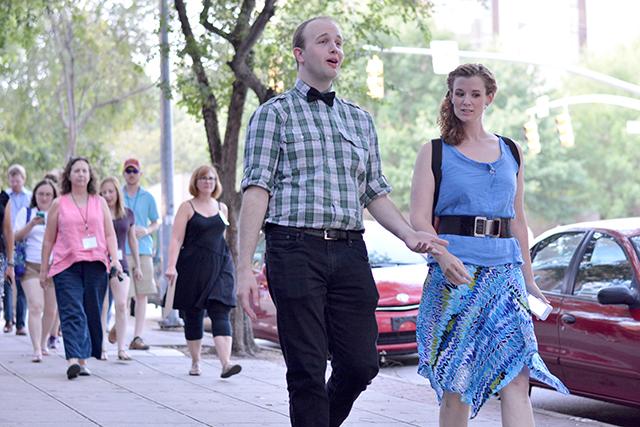Theater educator Sue Scarborough knew she wanted to break the boundaries of conventional theater, but she could only see the faintest glimmer of a story unraveling.
Cue Moving Pieces, a play in which the Raleigh Warehouse District serves as the backdrop for audience members to move with the play’s four characters to venues such as Café de los Muertos and the Contemporary Art Museum.
Add in First Night Raleigh, and anything could happen.
“There are lots of people down there and lots of art and lots of people are just talking and making connections,” Scarborough said. “It’s already exciting, and, so I thought about, what if we would use the First Night and the businesses that are out there, and the backdrop would be of these real locations, and we would put characters in them that could be there…and create a play with things around it—art, music, puppets—as all part of the experience.”
The problem, though, lay in the details.
“I liked that idea, but I really just couldn’t hear it,” Scarborough said. “I could not get to who those people were and what they were saying.”
That’s when she enlisted the help of former student Logan Sutton, who now serves as the play’s director. Sutton played Romeo in a high school performance of Romeo and Juliet put on by Scarborough, which followed the same style of movement but on a smaller scale given the space constraints of a high school, according to Scarborough.
“She approached me and she said this is my idea for a piece that surrounds Downtown Raleigh—a young couple on the precipice of a big decision in their relationship, and I said, ‘Okay, what else?’” Sutton said.
Sutton said he developed the characters and the rest of the story by thinking about what young couples often face in their relationships, such as opportunities abroad or graduating from college, but left the ending up to the audience.
Attendees and cast members exchange messages with one another as part of a texting group formed at the start of the play, according to Scarborough. In addition to choosing one of three endings, the messages also allow audience members to provide instantaneous commentary on the action unfolding around them.
“It sounds really silly because the first thing that they tell you when you go to a play is to turn off all your devices … and the first thing we say is turn them up, turn them loud, take selfies, we don’t care,” said Renee Wimberley, Moving Pieces producer and director of the Seed Art Share theater company. “We know that the audience is in when their texts have absolutely nothing to do with the actors and they are really about the story. It’s like watching people live-tweet ‘How I Met Your Mother.’”
Ten actors switch out between the four roles because not all of them can perform every First Friday the play runs, Wimberley said. This means the actors sometimes have to perform with people whom they have never rehearsed with.
The public location of the play made rehearsing at the venues a rare event, according to Scarborough. Instead, they made floor charts and tried to replicate the setup as much as possible.
“One cool thing about the show is it looks different every time because we don’t know how many hundreds of people are going to be in the street walking past us, or if there’s going to be a DJ playing Vanilla Ice next to us, which kind of also happens now. We’ve had fire trucks, a drone fly over, and we had to have actors and musicians that were brave enough and really fantastic in their craft enough that whatever was going on, they could play it,” Wimberley said.
In addition to the actors, the play also requires a 15-man creative team, as well as a musical ensemble complete with an a cappella singer, electric guitarist and bass player, according to Wimberley. The musical crew adds an extra layer of commentary and finishes the show with a dancing finale.
“At one point Anne-Claire Niver sings ‘Will You Still Love Me Tomorrow,’ and she sings it three different ways as the story is progressing and that’s kind of a theme running throughout the whole show as we find out what happens to the main couple,” Wimberley said.
The venues also drive the plot because Sutton said he had to make sure the characters had a reason for going there, which exposes audience members to places they might never have encountered before.
After seeing the venues firsthand, attendees may also purchase items from the venues, such as costume pieces worn by the actors, as part of an interactive playbill found on the show’s website, Wimberley said.
“I like theater where you don’t sit in a dark room and watch actors on stage,” Scarborough said. “I like theater where the audience is more personal with the experience and I like theater that is, to me, very exciting and different.”
Scarborough said she hopes to continue the play’s story in the future by directing another piece with two of the characters this spring.
To purchase tickets or learn more, visit www.movingpiecesraleigh.com. Shows run every First Friday during the summer at both 6:30 and 8:30 p.m. and start at Café de los Muertos at 300 W. Hargett St.








